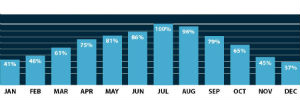“ET” stands for evapotranspiration and is how the soil loses water through evaporation (evapotranspiration) and plant transpiration (evapotranspiration). “ET” controllers keep track of the moisture level in the soil by calculating or measuring the amount of water leaving the soil through evapotranspiration and the amount entering the soil via rainfall and irrigation. By keeping track of the water entering and leaving the soil, it knows exactly when it needs to irrigate to keep your plants and lawns healthy.
YOU DON’T HAVE TO ADJUST THEM
The air temperatures we have during spring, summer, and autumn very wildly. In the Montreal area, we can expect anything from 0 degrees Celsius in spring and autumn, all the way to 35 degrees Celsius in summer.
 We can tell you that almost 90% of our clients irrigate with the same schedule, month after month, year after year. They water the same amount, regardless of the weather. Even though most people start their systems in the spring, everyone seems to program their controllers for the warmest summer weather. They do this to ensure they receive enough water for the driest time of the year.
We can tell you that almost 90% of our clients irrigate with the same schedule, month after month, year after year. They water the same amount, regardless of the weather. Even though most people start their systems in the spring, everyone seems to program their controllers for the warmest summer weather. They do this to ensure they receive enough water for the driest time of the year.
Why you might ask, well most people do not know how to program their controllers and do not have the time to learn how. We offer every year to show our clients how, but for most people, it is not a priority. It should be. Programming a controller like this waters too much in April, May, June, September and October. These are times of the year that are most critical for your lawn and plants.
An ET controller makes adjustments to its schedule every 24 hours. It never waters too much or too little. It automatically adjusts itself for heat waves, rainy weather, and even shuts itself off if any freezing weather sneaks up on us.
THEY PRODUCE A MUCH HEALTHIER LAWN
The health of your lawn ultimately depends on the health of its roots. ET controllers will help your lawn develop a deeper, healthier root system automatically. Standard controllers often have the opposite effect.
 It is in spring and autumn that your lawn will expend energy to develop its root system. If the lawn is constantly saturated with water, no oxygen reaches the root system and growth is stunted. This is exactly what happens with conventional controllers that are not adjusted. Not only can the roots be stunted, they may even stop growing or recede. When the same amount of water is put in the ground, year in and year out, the roots learn that they don’t have to grow deeper to get water. The water is always at the surface and unfortunately, that is where the roots will stay.
It is in spring and autumn that your lawn will expend energy to develop its root system. If the lawn is constantly saturated with water, no oxygen reaches the root system and growth is stunted. This is exactly what happens with conventional controllers that are not adjusted. Not only can the roots be stunted, they may even stop growing or recede. When the same amount of water is put in the ground, year in and year out, the roots learn that they don’t have to grow deeper to get water. The water is always at the surface and unfortunately, that is where the roots will stay.
How do you solve this? You don’t water until the top 50-75% of the soil around the root system has dried up. This allows oxygen to reach the roots through the surface, and the root system will continue to grow deeper in search of water. The plant learns that water is always available deeper in the ground, but we never let more than 75% of the soil to dry up so that we do not stress the plant.
As the roots grow deeper and deeper, the amount of irrigation required is decreased. This is because the upper few inches of soil is where the water evaporates from in the heat of the summer. Below this, most of the water remains available to the plant regardless of temperature, thus saving water and your lawn in times of stress. The deeper the root system, the more resources the plant has available to it when the hot weather arrives.
THEY SAVE MONEY AND EXTEND THE LIFE OF YOUR SYSTEM
Every time an ET controller reduces the amount of water required for your landscape, it saves wear and tear on your system’s components and extends the longevity of your system.
 Most people don’t think about the savings an ET system can provide in simple wear and tear. Most people can expect water savings in the order of 30-50%, depending on how they were watering previously. That is not just saving in water, that is a 30-50% reduction in operating times.
Most people don’t think about the savings an ET system can provide in simple wear and tear. Most people can expect water savings in the order of 30-50%, depending on how they were watering previously. That is not just saving in water, that is a 30-50% reduction in operating times.
Every time you reduce the amount of water you use or eliminate an irrigation cycle due to rain, you are decreasing the wear and tear on your system. Even if we consider a very conservative water savings of 30%, you could effectively expect a component that has an average lifespan of 10 years to now last up to 13 years.
So even if you do not pay for your water, you will still reap benefits from an ET system in reduced maintenance and repair costs. It could pay for itself in as little as 2 years.
THEY REDUCE THE AMOUNT OF WEEDS
Unless you actively make adjustments to your controller multiple times a week, you are probably watering too much. By over watering and keeping the soil moist, you are creating the ideal environment for weeds to germinate, grow and flourish.
 The ability to maintain a beautiful weed free lawn is becoming increasingly more difficult with the absence of pesticides. Many people miss the ease at which we were able to maintain weed free lawns back when pesticides were in wide use. The times have changed and we have all come to accept that we need to find other solutions. Unfortunately, organic and all-natural replacements simply cannot do the same job as the stronger pesticides we used to use.
The ability to maintain a beautiful weed free lawn is becoming increasingly more difficult with the absence of pesticides. Many people miss the ease at which we were able to maintain weed free lawns back when pesticides were in wide use. The times have changed and we have all come to accept that we need to find other solutions. Unfortunately, organic and all-natural replacements simply cannot do the same job as the stronger pesticides we used to use.
Hope is not lost. One of the best ways to prevent weeds is to maintain a healthy lawn. A healthy lawn will naturally chock out any weeds that do develop in addition to preventing the spread of existing weeds. Nothing will produce a healthier lawn than an ET based irrigation system.
In addition to developing a healthier root system for your lawn, an ET system is designed to not water until it is necessary. This helps the roots grow deeper and in turn decreases the frequency with which you will water. The less often you water your lawn, the less often you water any germinating weeds. You thereby starve the weeds of water at the surface, all while maintaining the proper amount of water for your lawn.
THEY SAVE TONES OF WATER
ET controllers measure and adjust their programming every 24 hours. They are constantly reevaluating the water requirements for your property. How much thought and effort do you expect to put into saving water?
 ET controllers work by determining where the water level is in the soil and they schedule irrigation only once the top 50-75% of the soil has dried up. The controller calculates the amount of water lost from the soil on a hot day, or how much is added to the soil when we get rain or irrigate.
ET controllers work by determining where the water level is in the soil and they schedule irrigation only once the top 50-75% of the soil has dried up. The controller calculates the amount of water lost from the soil on a hot day, or how much is added to the soil when we get rain or irrigate.
With our typical weather here in Montreal, you could expect an ET based controller to water maybe twice during the months of April and May. A standard controller programmed to water 2-3 times a week will water 20 times during the same period. That is a factor of 10 times too much water in spring. The same is true in autumn. All this water is wasted because it wasn’t required and was actually detrimental to the plant.
To put that in perspective, a typical system uses 10 gallons of water a minute and might water for 3 hours each time. That is 1,800 gallons of water each time you irrigate. If we consider only spring and autumn, the system above will water 20 times in spring and 20 times in autumn, for a total water use of 72,000 gallons of water. The ET based system might water 4 times using a total of 7,200 gallons of water. A difference of almost 65,000 gallons of water.
Extrapolate that over 10 years, and you could be wasting 650,000 gallons (2,500,000 liters) of water.
